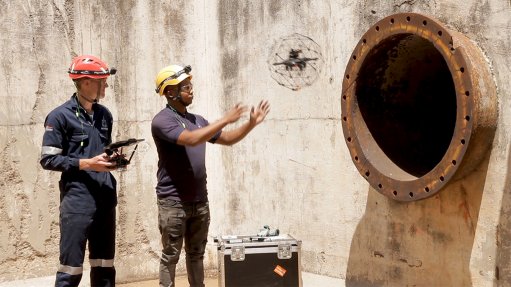
TAKING FLIGHT The drones have been designed for indoor use
Using drones, in addition to rope access, can result in boiler inspections being done at a fraction of the cost and much quicker, notes rope access specialist Skyriders.
“Drones can be used to inspect boilers without having to erect scaffolding, which could, in some cases, be unnecessary if major maintenance is not required after the inspection,” says Skyriders marketing manager Mike Zinn.
He explains that, owing to the large size of some boilers, erecting scaffolding will not only be expensive but also unnecessary if all inspections come back clear of fault. “It is for this reason that we use the drones to conduct initial inspections of the boiler.”
The drones have been designed for indoor use by Swiss indoor inspection and exploration company Flyability.
These drones are ideal for use in spaces that might be difficult or even dangerous for personnel to reach, Zinn states.
The drones are also ideal in situations where time is a constraint and inspections need to be carried out urgently. Additionally, the drone is surrounded with a carbon fibre cage, which makes it collision-tolerant on impact by up to 15 m/s.
“A dirty boiler, which is one that is full of dust, can impair visuals. Also, boilers are large spaces meant to retain heat and are, therefore, very dark,” explains Zinn, adding that the lighting features and those of the onboard camera attached to the drone provide enhanced visibility in the dark surroundings of the boiler.
“With the onboard light-emitting-diode lights, thermal camera and full high-definition camera, the drone detects hot spots, which could be the cause of electrical faults, and conducts thorough inspections, owing to the clear camera imaging.”
The drones provide a 2.4 GHz live video feedback that can also be stored on the onboard secure digital card. This enables the pilot to receive live visuals when flying the drone, for members of the company to participate in inspections and for rope access specialists to view the footage at a later stage when maintenance needs to be carried out.
Moreover, using drones ensures a safe environment for the people that need to access the boiler after the initial inspection, although drones are not safe to use in explosives environments. Boilers have to be cooled down to between 36 ºC and 46 ºC before drones or rope access specialists can be sent in.
“While many thought that the introduction of drones would replace rope access specialists, we have found that a synergy exists between drones and people. This enables us to maintain the safety of our rope access specialists while carrying out efficient and thorough inspections in a time-saving and cost-effective way,” Zinn concludes.